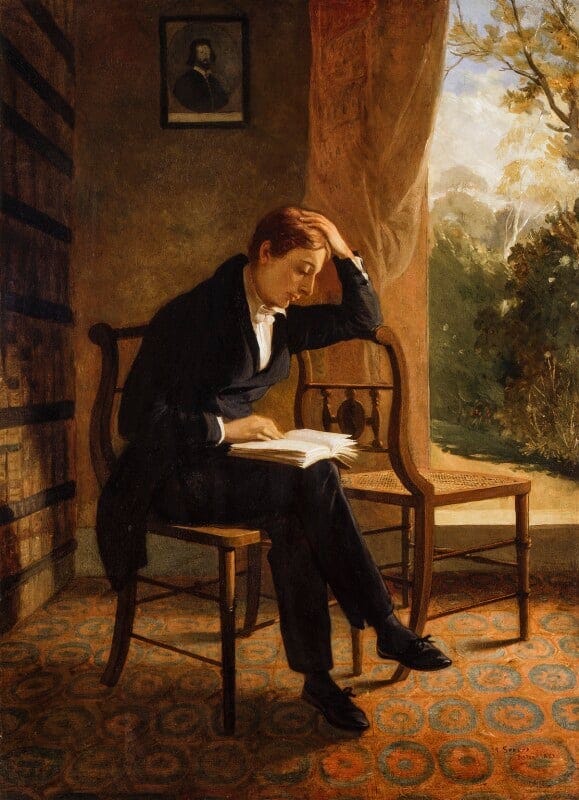Deep Dive.. John Keats
Hello friends and family!
Interested in a little deep dive back in time, into the realms of art, poetry and history? Okay! Let’s go!
Today, John Keats.. the English romantic poet (1795-1821)
Accompanied by a likeness painted posthumously by his good friend, English painter Joseph Severn.
John Keats lived a short life indeed wrought with a painful childhood, and embarked on his career while enduring more loss: the emigration of one brother to America and the other recently lost to consumption.. and yet with good friends around Keats imagined a bright future ahead.
The setting: England, in Hamstead London, Isle of Wight, Margate, Burford Bridge (with one excursion to the Lake District and to Scotland).
After contracting tuberculosis himself in mid-1819, Keats experienced a long, tumultuous heralding of the end of his life, with periods of remission and great writing, and of convalescence and worsening illness.
In November 1920, Keats and his painter friend Severn departed for the warmth of Rome, where Severn remained faithfully by his side, and Keats died peacefully in Severn’s arms 23 February 1821.
Yes, this sounds bleak, but the fact is, in this short period of time, magic happened. Let’s dig in a little deeper..
⭐️
We’ve heard the quote before:
“A thing of beauty is a joy for ever”
~ John Keats
..
In context, here is the entire passage:
From: Endymion, Book I, opening lines (c.1817)
A thing of beauty is a joy for ever:
Its loveliness increases; it will never
Pass into nothingness; but still will keep
A bower quiet for us, and a sleep
Full of sweet dreams, and health, and quiet breathing.
Therefore, on every morrow, are we wreathing
A flowery band to bind us to the earth,
Spite of despondence, of the inhuman dearth
Of noble natures, of the gloomy days,
Of all the unhealthy and o’er-darkened ways
Made for our searching: yes, in spite of all,
Some shape of beauty moves away the pall
From our dark spirits. Such the sun, the moon,
Trees old and young, sprouting a shady boon
For simple sheep; and such are daffodils
With the green world they live in; and clear rills
That for themselves a cooling covert make
'Gainst the hot season; the mid forest brake,
Rich with a sprinkling of fair musk-rose blooms:
And such too is the grandeur of the dooms
We have imagined for the mighty dead;
All lovely tales that we have heard or read:
An endless fountain of immortal drink,
Pouring unto us from the heaven's brink.”
..
Sometimes, a little poetry from one of the masters such as Keats helps us — at least for a moment — to forget about the misery being rained down on so many in the world, and to think about lighter things like beauty and our more noble natures.
This quote is from Keats’ very first great works, Endymion which comprises four books in total.
⭐️
John Keats (1795–1821) was an English Romantic poet, renowned for his vivid imagery, rich language, and exploration of beauty, transience, and mortality.
Though his literary career lasted only about five years, he is now considered one of the greatest poets in the English language.
His most famous works include “Endymoin”, “Ode to a Nightingale”, “Ode on a Grecian Urn”, “To Autumn”, and “La Belle Dame sans Merci”.
..
A lengthy biography on Keats can be found here and is very good, well worth your time, if interested:
https://www.poetryfoundation.org/poets/john-keats
From the biography linked above, the paragraph below stands out to me particularly related to the four books of Endymoin:
“…Keats’s victims begin unable to define their plight or even comprehend how they differ from gods and came to fall. Their fall is in the nature of some cosmic process, echoing the Romantic age’s fascination with historical revolutionary forces (the parallel to Napoleon and the French Revolution has been suggested), with lost golden ages succeeded by self-conscious, demythologized modernity. The reader also understands the personal relevance to Hyperion of Keats’s conception of the modern poet, born to Apollo’s radiance by his identification with human suffering. The fall into self-consciousness would itself be redemptive if it formed the soul of a poet, whose creation of beauty is the more intense for his having felt and transcended tragic pain and the loss of faith.”
..
What if this is relevant today:
Tragedy, pain of loss and human suffering are necessary components within the cosmic process and as fundamental as the revolutionary call to rise out of self-conscious, to adopt the soul of the artist, the soul of the poet, and through art, poetry and the enchantment of beauty in nature, we can — at least for a time, or a moment — become redeemed. Love. ♥️
⭐️
Image: Portrait of John Keats (1821–1823), (22 1/4 in. x 16 1/2 in.), in the public domain, from Wikipedia.
by English painter, Joseph Severn (1793–1879).
This posthumous oil painting by Joseph Severn, a close and trusted friend of Keats, captures the poet in a moment of introspection after apparently to Severn first becoming ill. It is one of many painted by Severn in Rome after Keats's death in his arms.
It depicts Keats seated in his Hampstead, London home, possibly during the period he composed “Ode to a Nightingale.”
The original artwork is housed in the National Portrait Gallery, London.
Sources: Wikipedia, NPG.



